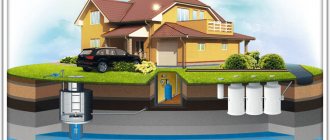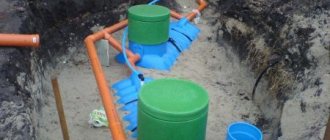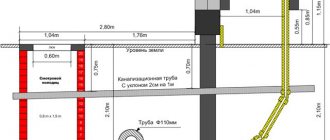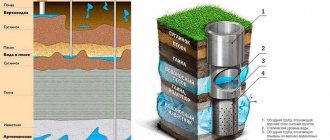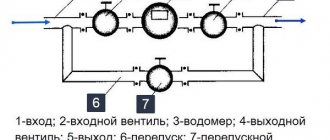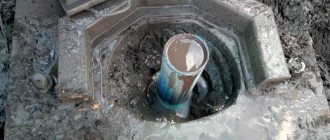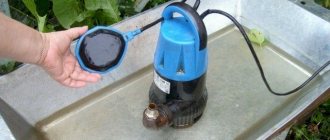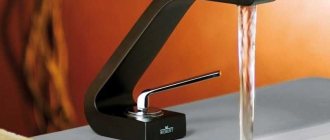The Abyssinian well, which is often called a “needle well,” is an affordable option for organizing a reliable water supply in a suburban area. Without water in the house there can be no talk of comfort. But if other sources are unavailable, digging a well is quite difficult, and drilling an artesian well also requires the use of expensive special equipment, arranging a “needle” can be a budget-friendly but productive way of providing life-giving moisture not only to a country house, but also to a summer cottage and a bathhouse.
Abyssinian well: what kind of device is it?
An Abyssinian well is a water intake metal or plastic pipe with a diameter of 2.5–4 cm, installed in an aquifer up to 10-15 m deep. At the bottom of the pipe there is a filter and a well tip, the so-called “needle”. A hand pump or a pumping station powered by electricity is installed on top of the pipe.
Nedrabur member FORUMHOUSE
Abyssinka attracts country residents with the opportunity to solve the problem of water supply for their plot, bathhouse, and even their country house of permanent residence without the arrival of heavy equipment.
The productivity of the Abyssinian, depending on the “thickness” of the aquifer, can reach 3–5 m3 per hour.
Pros and cons of Abyssinian
Pros:
- Efficiency of work. Can be drilled in one day. Depending on the soil and depth, the work takes 5 - 8 hours.
- Low price. This is the most economical way of autonomous water supply. This applies to the price of work and operation.
- Service life of a water well. The Abyssinian well operates for up to 30 years. However, the duration depends on the water quality and soil type. Fine sand entering through the holes of the pipe and the impurities contained in it contaminate the well, reducing its resource.
- Compactness: the Abyssinian spring does not need much space. The work is carried out without special equipment in basements or garages. By hammering it in the house, they protect the source from external contaminants. If located outdoors, make a caisson or pit.5. Water return with high performance. Makes up 1 - 2 cubic meters. m. per hour.
Disadvantages of the Abyssinian well:
- Method of water supply. Surface electric pump. Which increases costs and requires electricity on site. If you use a hand pump, you will need to use force, and the flow rate will be low.
- Need to search for water. It is not possible to install the needle everywhere. It is difficult to determine water in a limited area at shallow depths. Sometimes drilling has to be done in different places.
- Dependence on soil. Only do this in areas with coarse sand or bedrock.
- Water quality. Water from the first aquifer is susceptible to contamination. The Abyssinian well must be installed at a distance from possible sources of infection (septic tank, collective farm fields treated with chemicals, baths, compost, etc.). Passing wastewater through 10 meters of soil is not enough to completely clean it, so the water must be tested periodically.
- The Abyssinian well is a one-time design. If the filter is clogged, you will have to drill again. The hydraulic structure is suitable for seasonal work. The installation produces moderate volumes of process water in a private home or country house, in the absence of small rocks in the soil.
Advantages of the Abyssinian well
Among the advantages of the Abyssinian well are:
- Relatively cheap: you can make a well yourself, and everything necessary for its construction can be purchased at the nearest construction market;
- High production speed: on average, it takes several hours to install it;
- Simplicity: it can be installed in a limited space (the subfloor of a house, basement or garage is suitable), as well as anywhere on the site;
- Ease of arrangement: no special heavy drilling equipment or access roads for vehicles are required;
- Long Lifespan: A properly constructed Abyssinian plant can provide clean water for many years.
How to make a filter for an Abyssinian well
The longevity of the “needle” largely depends on the chemical characteristics of the aquifer and the efficiency of its filter.
Alextr61
I recommend making a good filter like this: buy a galvanized thick-walled pipe 1.5 m long. Cut threads on both sides. We screw a pointed “needle” tip onto the base of the pipe (it pushes the soil apart) with a diameter 20 mm larger than the diameter of the pipe (the junction of the tip with the pipe can be welded for strength).
You need to retreat 0.5 m from the base of the pipe. We leave this distance for the sump under the sand. Then, every 50 mm, we drill holes with a diameter of 10 mm in a checkerboard pattern. We wrap the section of pipe with holes with stainless wire with a diameter of 1.5 mm. After this, we additionally wind two layers of stainless steel mesh with small-diameter holes.
We do not boil the mesh on top, but secure it with stainless steel clamps. For better filtration, the pipe can be wrapped in geotextile and secured with steel clamps.
If the aquifer contains a large amount of impurities, and the filter of the Abyssinian well is made with technological violations, then it will become silted, which will lead to a decrease in water quality and rapid failure.
At FORUMHOUSE we described in detail how to make a filter for an Abyssinian well and what technical requirements are required for it.
Disadvantages of the Abyssinian well
For all its advantages, this type of water supply has several disadvantages. The Abyssinian well cannot be installed everywhere - there are areas where it is better not to even mess with the “needle”.
- The Abyssinian well is installed “on sand”. If there are thick layers of clay, limestone and large stones on the site, constructing such a well is impossible or economically infeasible;
- To lift water from it, it is necessary to use a pumping station (it is impossible to install a submersible pump in a small-diameter well). The distance from the top point of the well to the water surface in the pipe should not exceed 8 m, and the “needle” itself can be clogged to 10-15 meters. If the distance to the water surface is more than 8 meters, then you will have to install a pumping station lower, dig a pit in the underground or install a caisson on the street. If the aquifer is located lower (20 meters or more), then the pumping station simply will not be able to lift water from such a depth.
Details
Material for well construction
The equipment for work and the installation of the well - igloo - are simple. To construct a well you will need:
1.rolled steel pipes having a diameter from 1 to 1.5 inches and a length from 1.5 to 2 meters. The lower pipe should be perforated; it will be driven in first, through which water will flow into the well.
2. a mesh-type filter, which is placed on the surface of a perforated pipe.
3. couplings with threads for joining rolled pipes of suitable diameter.
4.a needle in the form of a metal tip, similar to a cone, to facilitate the deepening of pipes. In this case, the needle must have a larger circumference than the pipe so that it does not rub against the ground when it is hammered.
5. the presence of a steel piledriver, representing a hammer, or a massive “woman” made of steel as impact equipment. It should have a hole smaller than the diameter of the pipe, so that when the pile driver is lowered, it can achieve centering of the impact.
6.a tip for driving, which is put on the end of the pipe. It is made from hard metal alloys and prevents the end of the pipe from being flattened when it is struck during driving.
The driving tool must be installed using a tripod; blocks are attached on top to throw a cable to lift the pile driver up. If a manual method is used to hammer a pipe, then you can use a sledgehammer or a metal “woman” with two hands. The ends of the pipe rolls are equipped with threads to connect them using a coupling. A special tip is screwed onto the end of the pipe that is being hammered.
How to choose a site for installing a well
Attention! In order for the Abyssinian well to work correctly, you must choose the right place to install the structure.
The area where the well will be created must have soft soil. If, during the slaughter of a well, rocks or compressed clay are discovered, it means that the installation will have to be interrupted and another area chosen for slaughter. It is important to have an idea of the approximate distance to where the upper layers of water are located. The most effective structure is considered to be a well dug to a depth of 5 to 8 meters. If the depth is greater, then pumping water using a manual pump and other pumping devices will become problematic.
The approximate occurrence of water can be determined by the wild grass and trees on the site. If spruce trees grow, then the water layer is located at a depth of 2 to 8 meters. An ancient way to determine a layer of water is to use a rod. Instead, you can take two twenty-centimeter copper wires, which are bent at an angle of 90 degrees. You need to take these wires in your hands, they should be relaxed. The wires will cross in an area where the water flows high.
Installation
To pump water from a well, manual pumps or electric pumps are used.
The hand pump is installed on top of the outermost pipe, which protrudes outward. Power plants for pumping water are installed in caissons in which a certain temperature is maintained. Electric type pumps can operate when the ambient temperature is above 5 degrees above zero. If the water freezes in the pump, it will break. A caisson is a concrete well with a well at the bottom. The depth of the caisson should be greater than the freezing level of the soil. This value varies in different regions of the country: in areas in the south near the sea the depth reaches 0.5 meters, in the middle zone from 0.8 to 1.2 meters, in Siberia from 2 to 3 meters.
Attention! The caisson is covered with a lid and must be insulated.
To connect a well in a well to a pump, use a hose that is lowered into the pipe. The base of the caisson is concreted, maintaining a slope towards the edge of the well from the well. To prevent flooding of the caisson in emergency situations, drainage is installed in it. In such a situation, the slope of the concrete base is made towards the drainage hole.
When choosing a pump, they rely on the debit indicators of the well, in other words, productivity. If the pump power is too high, the well will quickly dry up, and the pump running idle will burn out.
Construction of a well with your own hands. You can make an Abyssinian well with your own hands. During installation, the following sequence should be observed:
1.prepare the workplace. You should remove the turf and use a garden auger to make a hole of 0.5 to 1 meter in the soil.
2. if a piledriver will be used during work, then you need to build a tripod from bars or metal.
3.prepare the pipes. A cone-shaped tip is put on the perforated pipe that goes first, and it is placed strictly vertically in the hole in the soil.
4. Place a driving tip on top of the pipe.
5.Using a copra, hit the tip. If the soil is sandy, the pipe passes quickly. If the hammer weighs 25 centners, then in eight blows a 2.5 centimeter diameter metal pipe will penetrate a meter into the ground.
6. When the pipe is buried almost its entire length into the ground, then using a coupling, attach another one to it, and continue working.
7.pipes should be driven until the aquifer begins. To prevent water from passing through the horizon, you need to fill the pipes with water when they are deep enough. The aquifer on top is free-flowing and has a porous structure. Water will quickly flow through the perforations and filter. If this result appears, it means that the aquifer has been reached; there is no need to deepen the pipe further.
Attention! It is impossible to pass through the aquifer.
8. A pump is mounted to the well and the liquid is pumped out. The first water will be muddy and sandy. When up to two hundred liters of water are pumped, it will become lighter.
Abyssinian well: necessary conditions
Before you get to work constructing a “needle”, you need to understand whether it is suitable for your area. Therefore, first of all, we find out the depth of the aquifer (even in different areas in the vicinity of Moscow, the depth of the aquifer can vary up to 250 meters) and the type of soil.
When choosing a source of water supply, you should focus on existing water intake wells of a similar design located in close proximity to your site. And in their absence - for exploratory drilling and other reliable geophysical survey methods.
To search for water, different methods are used: from dowsing to geodetic maps, which display soils and aquifers.
Rules for drilling when constructing a water intake
The water intake should be carried out while noting the speed of drilling. If it grows, it means you have reached the aquifer, and if it falls, it means the drill has entered the clay, drilling should be stopped. With proper drilling, a good water intake flow rate is maintained. In order not to confuse the aquifer with quicksand, when reaching it, it is necessary to lower the float.
Afterwards, you must take the water for chemical and bacteriological tests and pump it. You can make the “Abyssinian” yourself, but it is better to ask for help from knowledgeable specialists. This way you will be completely confident in the success of this event.
Abyssinian wells and site features
Much depends on the individual characteristics of the site. So that your efforts and money are not wasted, and the Abyssian well does not remain a useless monument to your carelessness, a number of points should be clarified before constructing it yourself:
- The depth of the aquifer. To do this, you can ask your neighbors about the water level in their wells, and also measure the distance to the water surface. If the depth of the wells does not exceed 12-15 m, and the distance to the water surface is no more than 5-10 meters, then there is a high probability that the “needle” will be able to provide the house with water;
- Estimated water quality. The Abyssinian is a shallow well, and this aquifer may be susceptible to bacterial and chemical contamination. Therefore, it is necessary to find out in advance where septic tanks and sewage pits are located, and whether there are sources of chemical pollution nearby. Sometimes, already at this stage, it is necessary to abandon the construction of a well;
- Proposed location for the “needle” device. It can be installed right in the house, in the technical room, then the pumping station and other equipment will be protected from adverse weather conditions, and the well itself from freezing in winter (if the house has permanent residence). If the well is supposed to be installed on the site, then it is better to locate it close to the house. In this case, to bring water into the house, you will have to manually dig a trench under the main line, installing a caisson or an insulated shelter, which leads to additional expenses;
- Estimated needle debit. It largely depends on the saturation of the aquifer. An indirect sign can be the water level in neighboring wells. You should also find out whether they dry out in the summer.
A good water-bearing formation under the “igloo” is located in a vein with coarse (river) sand.
Nedrabur member FORUMHOUSE
The most advanced design of an Abyssinian well will not save you if the aquifer has poor water yield and low thickness.
If the water yield of the Abyssinian is low, you will have to purchase and install a storage tank for water of 500-1000 liters.
The water yield of an already installed well can be found out this way: we note the time of filling the measuring container and see how long it takes to fill a 10-liter bucket. Without stopping pumping, we repeat the procedure 2-3 more times in 10-15 minutes, and we get the average value - the specific flow rate of the well.
How to make an Abyssinian well yourself: manual methods
There are two main ways to construct an Abyssinian well:
- Plugging a well with a steel "woman".
- Drilling using a small-sized auger.
Auger drilling requires the presence of special and not always accessible equipment, so we will dwell in more detail on manual methods of drilling a well.
Abyssinian well: driving with a steel “woman”
When driving a well with a “woman,” a special metal pig weighing 40-50 kg is put on the pipe, with a hole in the center and two handles on the sides. A “headstock” is attached to the pipe - a special clamp tightened with bolts. The “grandmother”, being a stop for the “woman”, upon impact transfers all the energy to the pipe and the “needle”, which gradually enters the ground. As the pipe moves deeper into the rock, additional elbows are screwed onto the pipe, one after another, through couplings until the “needle” reaches the specified depth.
You can also screw a special nozzle onto the head of the pipe, which will be used to deliver blows. This method of constructing an Abyssinian well is demanding on the quality of the thread, because a lot of pressure falls on her.
Fludik member FORUMHOUSE
I assembled the “igloo” using steel couplings and tow (flax) with paste, because... Cast iron fittings may burst due to impacts. While driving, I constantly tightened the column clockwise with a wrench.
To control the immersion depth of the column and facilitate the passage of soil, water is poured into the pipe.
When the water reaches the aquifer, it leaves the pipe with a characteristic noise. After this, you can add another meter to the column (so that the entire filter is in the water layer) and try to pump the “needle”.
Yuri member of FORUMHOUSE
When water is poured into a pipe, it can go either into the space between the pipe and the clay/dry sand, or into the aquifer. We rock the column with a hand piston pump. And only then we connect the electric one.
Alextr61 member FORUMHOUSE
After driving the Abyssinian, at first I had muddy water with fine sand and suspended matter.
After pumping about 500 liters, the water came out clean. Somewhere after 1000 liters, the water began to be used for drinking.
As the well is pumped and a water lens is washed around the “needle” filter, the water will flow cleaner and purer. We invite you to familiarize yourself with our article, which discusses in detail the construction of an Abyssinian well using the method of driving it with a steel “woman”.
"Device Arrangement"
The design, invented a long time ago, has not changed very much since then. Perhaps because for some time the Abyssinian wells were forgotten. There are 2 ways to achieve the goal - driving method and drilling. No, there are more, but these are the most popular.
You can't do without a woman
This fairly simple device consists of two main parts.
- Drilling rig. This is a sharp cone-tip that cuts the soil, and a trunk - a pipe, which is expanded during work as it goes deeper into the soil.
- A pile driver is a part that includes a metal tripod and a heavy (concrete) projectile. The top of the first element is equipped with two blocks through which strong ropes (cables) are pulled. A load is tied to them, which is called a “construction woman”.
By pulling the ropes, the heavy weight projectile is lifted to the very top of the tripod. Then they are released, as a result the woman falls on the headstock - a kind of anvil, which is securely fixed to a piece of pipe. This is a clamp consisting of 2 parts. Its surface area is greater than that of the bottom of the projectile.
As a result of such actions, the trunk gradually goes into the soil. When one section of pipe is immersed in the ground, the headstock is removed, a new one is screwed to the trunk, then the clamp is fixed on it again. Such work is carried out until the pipe being built up reaches the aquifer. They not only open it up, but also go deep into the layer at least a meter. Experts recommend crossing 2/3 of it, but an amateur driller is unlikely to know the exact dimensions of the aquifer.
To periodically check for the appearance of water in the barrel, a fairly simple folk invention is used - a large nut fixed horizontally on a cord. When it comes into contact with water, any builder will definitely hear a rather loud splash. Another test option is to add water to the barrel. If it suddenly suddenly disappears, then the goal has been achieved. It is also important to determine when to stop drilling. This is done based on penetration rate. When they reach the aquifer, it increases. And falls again when the spear pierces the clay.
The advantage of the method is that the work can be completed fairly quickly and the desired Abyssinian well can be obtained. There is also a disadvantage, this is an increased load on the threaded connections. If they are damaged, loss of tightness is inevitable, so the water will become unsuitable for household needs.
Gentle drilling method
This type of work is more difficult, so it is better to use compact drilling rigs, but there is a homemade design that greatly facilitates the work. It consists of:
- tripods with collar;
- block fixed at the top.
The drill bit is removed from the ground using a block, cable and winch. In this case, the pipeline is not in danger of losing its integrity. An Abyssinian well is made using a special drill - an auger - a steel pipe with blades welded in a spiral. By rotating, the projectile is driven deeper into the ground. After it goes to its full depth, it is taken out, the soil between the blades is removed, and the operation continues. Pipes can have a threaded connection or be fastened with studs.
Since the latter method requires much more labor and the process takes a lot of time, most people prefer the first method. It is recommended to use self-made structures only if there is one hundred percent confidence in the proximity of water.
